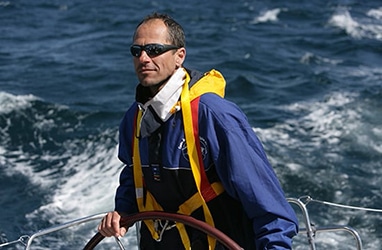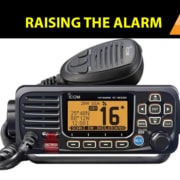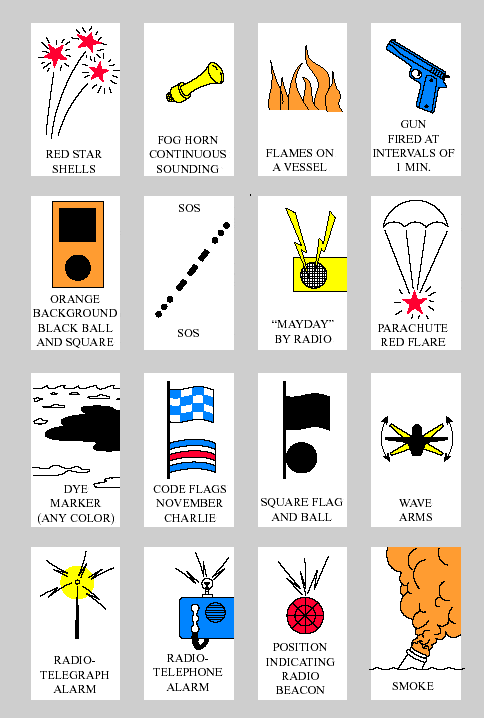Raising the Alarm in Emergencies
VHF
Procedure for VHF Channel 16 MAYDAY:
- Switch to Channel 16. All Distress signals via VHF are initiated on Channel 16. This is a worldwide protocol.
- Distress signal “MAYDAY”, spoken three times.
- The words “THIS IS”, spoken once.
- Name of vessel in distress (spoken three times) and call sign or boat registration number, spoken once.
- Repeat “MAYDAY” and the name of the vessel, spoken once with the call sign.
- Give the position of the vessel by latitude or longitude or by bearing (true or magnetic, state which) and distance to a well-known landmark such as a navigational aid or small island, or in any terms which will assist a responding station in locating the vessel in distress. Include any information on vessel movements such as course, speed, and destination.
- Nature of distress (sinking, fire, etc.).
- Kind of assistance desired.
- Number of persons onboard.
- Any other information that might facilitate rescue, such as length or tonnage of the vessel, number of persons needing medical attention, color hull, cabin, masks, etc.
- The word “OVER”
Stay by the radio if possible. You’ll probably need to repeat information and answer further questions, particularly concerning your location.
For example:
MAYDAY-MAYDAY-MAYDAY
THIS IS BLUE DUCK-BLUE DUCK-BLUE DUCK
Call sign WA1234 MMSI number 233006734
MAYDAY BLUE DUCK
Call sign WA1234 MMSI number 233006734
OUR POSITION IS CAPE HENRY LIGHT BEARS 185 DEGREES MAGNETIC-DISTANCE 2 MILES
OUR CONDITION, WE HAVE STRUCK A SUBMERGED OBJECT
WE REQUIRE PUMPS, MEDICAL ASSISTANCE, AND TOW
THERE ARE THREE ADULTS AND TWO CHILDREN ONBOARD
ONE PERSON HAS A COMPOUND FRACTURE OF ARM
ESTIMATE CAN REMAIN AFLOAT FOR TWO HOURS
BLUE DUCK IS A THIRTY-TWO FOOT CABIN CRUISER-WHITE HULL-BLUE DECK HOUSE
OVER
Repeat at intervals until an answer is received.
Keep in mind that you may know how to make a MAYDAY call but your crew may not.
Therefore Download this Mayday Call document – laminate and put it on your boat near the VHF radio.
Or download this smaller version, laminate it, and zip tie it to your VHF mic cord.
Calls Other than Distress on VHF
Urgency: “PAN, PAN, PAN” (PAHN PAHN PAHN). This is the International Urgency Signal and is used when a vessel or person is in some jeopardy of a degree less than would be indicated by Mayday.
Safety: “SECURITY, SECURITY, SECURITY” (SAY-CURE-IT-TAY). This is the International Safety Signal and is a message about some aspect of navigational safety or a weather warning. You will most often hear this from the Coast Guard. Listen and take appropriate actions if necessary. For example, perhaps a navigational aid has drifted off station or a tornado watch has been issued.
The United States Coast Guard’s website and recommendations on VHF distress signals is here:
Digital Select Calling (DSC)
Digital Select Calling (DSC) is a means by which a digital distress signal is broadcast via VHF Channel 70. Local Coast Guard stations monitor this in real-time. DSC will report your GPS position, your vessel name and type, and the nature of your distress via a selectable text menu. However, there is a caveat; when you buy your DSC you must register it and hook it up to your GPS unit. Instructions for this will be with the unit manual.
It is important to send a DSC signal first when in an emergency situation because pertinent information such as your vessel type, name, and position is broadcast digitally to all vessels in your VHF range vicinity, which gains more accurate and faster response times. After the DSC alert, you should send a voice alert. The Coast Guard monitors DSC 24/7. When they receive a DSC call they are instantly given extremely accurate and helpful information to speed and enhance the success of the rescue.
The DSC will likely have a selection of prescribed alerts from which you can select. If time is short, holding the red distress button will send a standard distress signal with your location. To initiate the DSC, open the distress cover and either (1) hold the distress red button for five seconds for the standard message or (2) press the red distress button and then select the best-suited message from the menu.
Watch this video interview with the Coast Guard.
USCG Video Interview
Now watch how to send a DCS message including a DSC distress signal.
Sending a DCS Signal
The United States Coast Guard’s website and recommendations on DSC distress signals is here:
EPIRB (Emergency Position Indicating Radio Beacon)
An EPIRB is an emergency device that will report distress and your position to monitoring stations via satellite. It is automatically set off when immersed in water and is automatically released from its mount if the boat is sinking. While not required in most countries, it is a must for every vessel.
This video is from the Survival at Sea team and discusses EPRIB as well as PLBs (Personal Locator Beacons).
EPIRB
Mobile (Cell) Phones and Satellite Phones
In today’s connected world, nearly everyone carries a cell phone, making it a convenient tool for raising an alarm in an emergency. It’s wise to save the phone number of your local Coast Guard station in your contacts. However, while cell phones can provide a critical line of communication, they have inherent limitations that make them less reliable as a primary emergency communication device offshore.
The most significant drawback of cell phones is that they facilitate only one-to-one communication. In an emergency, you’re speaking with a single person, not broadcasting to all nearby vessels and stations, as you would with a VHF radio. This lack of situational awareness means other mariners who might be in a position to assist will remain unaware of your distress. Additionally, cell signals are dependent on proximity to shore-based towers, typically fading beyond 10 to 15 nautical miles. Other factors, such as signal dropouts, garbled audio, non-waterproof designs, battery limitations, and the inability to transmit your position as effectively as Digital Selective Calling (DSC), further compromise their reliability offshore.
VHF radios with DSC remain the gold standard for nearshore emergency communication, providing a “one-to-many” alerting system within a range of approximately 20 nautical miles. The distress signal, including GPS coordinates when properly integrated, is broadcast to all vessels and stations within range, ensuring a rapid and coordinated response. Importantly, rescuers will be monitoring VHF channels, not cell phones, once they’re underway.
For those venturing further offshore, satellite phones have become a more cost-effective and practical option. Modern satellite networks, such as Iridium and Inmarsat, provide near-global coverage, ensuring communication even hundreds of miles from land. While they address the range limitations of both VHF and cell phones, they still operate on a one-to-one basis, meaning nearby vessels remain unaware of your situation unless specifically contacted. Furthermore, satellite connections can be affected by severe atmospheric conditions, leading to potential signal degradation or temporary loss of service.
Ultimately, while cell phones and satellite phones are valuable tools, they should complement, not replace, a properly installed and functioning VHF radio with DSC. Once rescue services are within range, switching to VHF for voice communication ensures clear, coordinated efforts. Understanding the strengths and limitations of each communication method is key to maintaining safety at sea.
SOS
What’s in a WordThe origin of SOS is interesting. While people commonly think of it as Save Our Souls or Save Our Ship, in actual fact, SOS stands for nothing. It was created as such because the Morse code signal is distinct and difficult to confuse with other signals. |
In Morse code, 3 shorts is “S” and 3 longs is “O.”
SOS, then, is 3 short, 3 long, 3 short. You are not expected to know Morse code, so the easiest way to not get mixed up between shorts and longs for S and O is that the message is logically the shortest message for emergency purposes (that is, 3 longs—3 shorts—3 longs would be a longer message than the correct message of 3 shorts—3 longs—3 shorts).
A flashlight or sound device can be used to make this signal.
Other Distress Signals
See our blog article on Flares
The United States Coast Guard, in their navigation rules (rule 37) shows this diagram for other distress signals.
Distress Signals
The Code V Flag, which is a large red X, is not a distress signal but it means “I require assistance.”
Other flags’ meanings are listed well on Wikipedia









